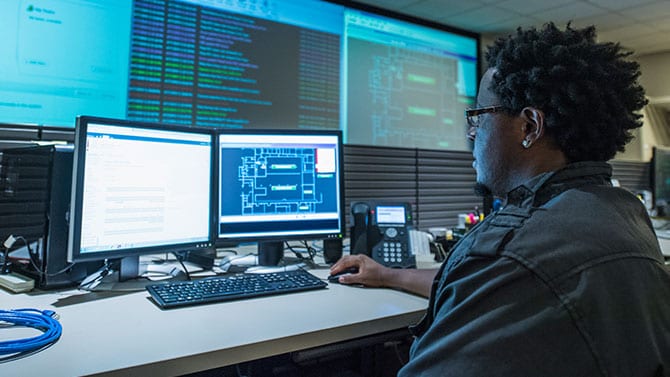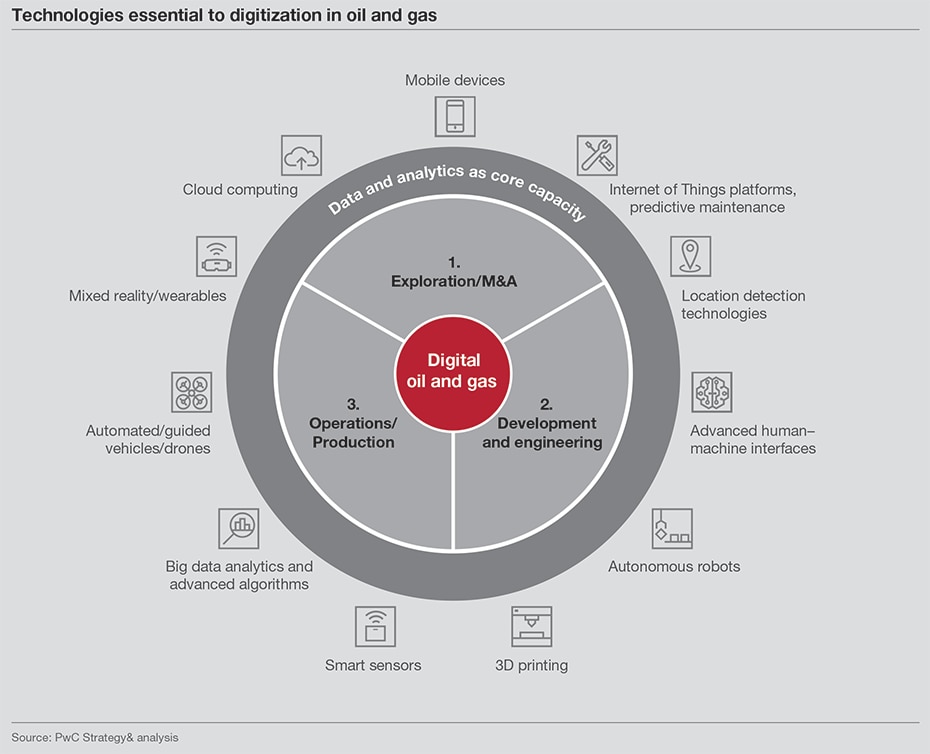Winning strategies for digital transformation
After a few years of small-scale pilots, leading oil and gas companies are making real strides in digitization. They have recruited chief digital officers, have designed digital strategies and established business units to promote them, have partnered with technology firms, and are striving to create a culture that nurtures new ways of working. These leading companies are deploying more new technologies, such as digital twins and drones, in the field.
At the same time, however, many operators, oil field service companies, OEMs, and others remain at an early stage of digital development. They may not have the same kind of financial resources, workforce, or capabilities as the so-called super maiors.
Our report provides examples of companies exploring digital solutions and analysis of how those companies have been transformed by new technologies. We also share lessons from those undertaking their own digitization journeys. Wherever you are in your digital transformation journey, we hope you'll find relevant insights here.
“Data and analytics capabilities are an important building block in enabling a data-driven approach that can transform businesses.”
Case studies: The road to digitization
Unsure what your first step toward digitization should be? Take a look at the common challenges we help business leaders address in these five case studies.
Building a digital strategy from scratch
A medium-sized independent energy operator faced challenges related to accessing and interpreting its data. The company wanted to develop its own digital strategy and become a leading adopter in digital technologies. But it was essentially starting from zero.
Strategy& helped design a digital strategy and identify which of the operator's business units globally had a strong need for digital solutions. Throughout the project, the operator used mini digital pilots and adopted a mind-set of willingness to explore and "fail fast," quickly pursuing new initiatives, such as Al, while adhering to lessons learned.
Ultimately, the operator's new digital strategy helped focus its digital investments. The strategy raised internal awareness of the importance of digital and thereby generated greater buy-in from employees. Additionally, the deployment of digital solutions helped technical functions allocate more time to higher-value activities. For example, by using Al in reservoir modeling, geologists could spend less time collating the data and more time interpreting it.

Developing a data analytics solution
A European independent energy operator was concerned about the buildup of deposits in a platform oil pipeline that would hamper flow rates. It wanted to develop a solution that would minimize maintenance costs and downtime.
PwC developed a model that could monitor flow rates and, by applying data analytics, could predict when the buildup of deposits might become problematic. The client was able to steer the project through a user-centric and agile management approach, thereby playing a central role in combining business understanding, technology, and user experience.
Finally, the client developed a stage-gate process whereby these technologies were tested and validated using a simple one-page business case. Each business summary explained the solution and the benefits derived for the business and end-users. If successful, a solution was expanded using the same stage-gate process.

Innovating with a technology partner
Production optimization is an ongoing challenge for operators tackling complex wells in challenging reservoirs, as well as those producing oil from complex subsea tiebacks. One example of this is Aker BP's fractured chalk reservoir at the Valhall oil field in the North Sea. When there was partial or complete blockage of the oil flow, Aker BP lost production and would have to engage third-party oil services firms to clean up the pipes. Though Aker BP had some sensor technology deployed, it had limited access to the real-time status of the flow.
In response, Aker BP partnered with a Norwegian oil services technology provider, Turbulent Flux, to deploy the latter's Virtual Flow Meter, a software simulator. By using live sensor data, the simulator monitored changes in inflow conditions from the reservoir to the well. Aker BP then complemented Turbulent Flux's solution with Cognite Data Fusion, a collection of microservices that gather and contextualize data to support recommendation tools and applications for the production staff.
As a result of these two solutions, Aker BP was able to detect chalk influx events in Valhall wells in the early stages, enabling the company to take faster remedial measures and optimize production. Annual savings using these solutions have been estimated to range from $600,000 to $1 million.

Enabling the ''connected worker'' in the field
An international oil company recognized the potential of digital technology to help upstream and downstream field engineers contribute toward a drive for improved productivity. But it was struggling to fully exploit digital capabilities in the field and align with other digital programs underway across the organization. In the absence of a clear route forward, the business's desire for new solutions was outstripping IT's ability to deliver solutions.
The company hired PwC to work across its business and IT departments to help shape thinking, understand the role of the field worker in a digitally enabled operation, and share examples from oil and gas and other industries. PwC's Connected Field Worker (CFW) framework was used to explore best practices in which digital technology enables upstream and downstream operatives.
The framework helped the client align business and IT stakeholders with a vision for how digital technology could be leveraged to increase field worker and asset productivity. The client was also able to develop a strategy and business case for investment in digital solutions, centered on a platform that enabled the rapid development and introduction of field mobility solutions and collaboration to enable engineers to maintain equipment.

Transforming into a data-driven culture
A midsized global exploration and production company undertook a strategic initiative to transform itself into an organization focused on improved use of data and analytics. The company soon understood there were challenges resulting from a lack of trust in the quality and consistency of data across the enterprise.
PwC was able to help the company establish and implement data-enabled solutions by developing an approach to capture and analyze key data across the business. It started with the creation of data blueprints - cataloging information from activities encompassing more than 80 critical technical data sets from operations, subsurface, land, and facilities to thirdparty industry sources. Technical information models were defined for more than 20 engineering and technical functions to support data foundation initiatives. Then life-cycle maps, definitions, data standards, data models, and processes were developed for critical master data sets, including wells, facilities, equipment, assets, and completion networks.
The data blueprints, technical information models, and master data solutions enabled the data science and engineering and technical functions to spend more time developing models, prototypes, and analysis, and less time locating and scrubbing data to support the models.

Five steps to digitizing your operations
As you decide where to focus your digital efforts, who to partner with, and how broad your aspirations for transformation should be, consider these five steps.



© 2019 - 2025 PwC. All rights reserved. PwC refers to the PwC network and/or one or more of its member firms, each of which is a separate legal entity. Please see www.pwc.com/structure for further details.




